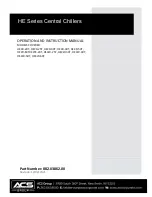
JOHNSON CONTROLS
51
SECTION 3 – OPERATION
FORM 160.81-NOM1
ISSUE DATE: 10/3/2020
3
Oil-rich refrigerant flows into the eductor block
through the filter drier from the evaporator. The oil rich
refrigerant mixes with the discharge pressure gas and
flows into the compressor suction line.
The filter driers should be changed annually or when
excessive amount of oil is indicated in the refrigerant
charge.
FIGURE 21 -
OIL SOLENOID VALVE ASSEMBLY
LD09033
LIQUID REFRIGERANT CIRCUIT
Liquid refrigerant flows from the condenser into the
evaporator by differential pressure. Sub-cooled liquid
refrigerant flows out of the condenser into the liquid
line. A variable metering orifice is installed in the liq-
uid line to control the rate liquid refrigerant flows into
the evaporator (see
). A liquid
refrigerant-charging valve is piped into the liquid line
between the evaporator and the metering orifice. A 3/4
inch male flare connection is provided for connecting
hoses or transfer lines.
TABLE 12 -
VARIABLE ORIFICE PRESSURE DIF-
FERENTIAL SETPOINTS
REFRIGERANT
DIFFERENTIAL
PRESSURE RANGE
R-134A
15 - 110 PSID
FIGURE 22 -
VARIABLE ORIFICE
LD07965
CAPACITY CONTROL
Capacity control is accomplished by using differential
gas pressure to move the slide valve. As the slide valve
is moved axially between the compressor rotors the
volume of gas pumped by the compressor is changed
to match the system requirements.
Leaving evaporator fluid temperature is continuously
monitored by the microprocessor. The Leaving Evapo-
rator fluid temperature is compared to the Leaving
Evaporator Fluid Setpoint. When the leaving evapo-
rator fluid temperature is beyond the range of the set
point value a signal is sent to the relay output board. A
signal is sent from the relay output board to energize the
control block valve directional solenoid valves.
Manual isolation valves are incorporated into the ca-
pacity control plate to isolate the directional valve for
service. Remove the caps to gain access to the service
valve stem. Use a refrigeration service valve wrench to
close or open the valves.
















































